HYDRIC STRESS ON VINES
 The anthropical climatic evolution recorded since the beginning of XIXth century can be seen through deep changes in bioclimatic variables:
The anthropical climatic evolution recorded since the beginning of XIXth century can be seen through deep changes in bioclimatic variables:
• an increase in temperatures (average maximal temperatures): From 1972 to 2002 :
+1.3°C in Bordeaux, +2° in Colmar, +1,5° in Montpellier. From1980 to 2006: +2°C over the spring season with an increase in PET* from 100 to150 mm (i.e. +15% between 2001 and 2007) in Montpellier.
• rainfall deficit: From 30 to 50% compared with the average figures recorded in the last 50 years throughout the whole regions in France.
This situation tends to generate earlier hydric stresses (more than 90% water helps regulate temperature in plants). At the early stage of plant life – flowering, vines feed can thus be prematurely limited and harvest quality subsequently altered (tab.1).
This climatic evolution can affect perennial crops by acceleration of phenology with shortening of crop cycles (for instance the William pear cycle was one month ahead of its former flowering stage between 1962 and 2002). This trend toward warming which is marked by hydric stress from early flowering may eventually concern the whole part of crops and generate an imbalance in the adaptation capacity of varietals and affect the typicity of terroirs (Syrah and Viognier exceeded their thermic optimum between 1989 and 2007) ref.: Supagro ENSAM, ACH, INRA, ENTAV-ITV
*PET : Potential Evapotranspiration of crops for their thermic regulation

The solution
ANTYS program for the nutrition and quality of vines in hydric stressful situation:
ANTYS NPK (Antys 15, Antys 8) : Restart nutrition in low temperature situation or hydric stress. Corrects soils nutritional deficiencies.

